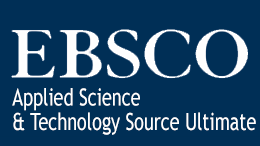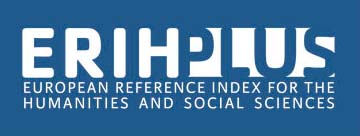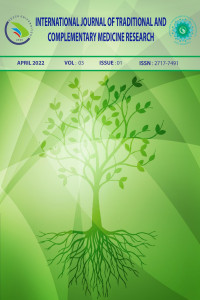Abstract
References
- Ağyar Yoldaş P, Yoldaş T, Sipahi N. Cytotoxicity of Some Retail Food Supplements. International Journal of Traditional and Complementary Medicine Research. 2020; 1(3): 131-136.
- Sipahi N. Investigation of Antagonistic Effect of Probiotic Food Supplement against Different Strains of Bacteria. International Journal of Traditional and Complementary Medicine Research. 2021; 02(02): 95-100.
- Sipahi N, Göç Rasgele P, Kaya E. 2021. Pharmacological Properties of Apitherapy Products. Atayoğlu AT, editor. Apitherapy, first edition Ankara: Türkiye Klinikleri; p.55-60.
- Sorucu A. “Bee Product and Apitherapy, Bulletin of Veterinary Pharmacology and Toxicology Association. 2019;10(1), 1-15.
- Seven I, Seven PT, & Silici S. “Effects of dietary Turkish propolis as alternative to antibiotic on growth and laying performances, nutrient digestibility and egg quality in laying hens under heat stress”, Revue de Médecine Vétérinaire, 2011;162(4), 186-191.
- Li J, & Kim I H. “Effects of Saccharomyces cerevisiae cell wall extract and poplar propolis ethanol extract supplementation on growth performance, digestibility, blood profile, fecal microbiota and fecal noxious gas emissions in growing pigs”, Animal science journal, 2014;85(6), 698-705.
- Wang K, Jin X, Li Q, Sawaya A.C, Leu R.K, Conlon, M. A, Hu F, et al.. “Propolis from Different Geographic Origins Decreases Intestinal Inflammation and Bacteroides spp. Populations in a Model of DSS‐Induced Colitis”, Molecular Nutrition & Food Research. 2018;62(17), 1800080.
- Yildirim A, Duran G.G, Duran N, Jenedi K, Bolgul B.S, Miraloglu M, Muz, M. Antiviral activity of hatay propolis against replication of herpes simplex virus type 1 and type 2. Medical science monitor: international medical journal of experimental and clinical research. 2016;22, 422.
- Kolaç T, Gürbüz P & Yetiş G. Phenolic Content And Antioxidant Characteristics of Natural Products. Journal of Vocational School of Health Service. 2017;5 (1) , 26-42
- Bakkaloğlu Z. , Arıcı M. Effects of Propolis Extraction with Different Solvents on Total Phenolic Content, Antioxidant Capacity and Antimicrobial Activity. Academic Food Journal. 2019; 17(4): 538-545.
- Dönmez M., Karadeniz Ş, Yoldas T, Aydin G, Karagül P, Aksu O et al. Comparison of Chemical Contents of Extracts in Different Solvents of Propolis Samples Produced in Duzce Province. International Journal of Traditional and Complementary Medicine Research. 2020;1(3), 137-146.
- Mendonça, I. C., Medeiros, M. L., Penteado, R. A., Parolia, A., & Porto, I. C. (2013). An overview of the toxic effects and allergic reactions caused by propolis. drugs, 4, 7.
- Yıldız, O. (). Evaluation of Solvents (Menstruums) Used In Consumed Propolis Extracts. Uludag Bee Journal. 2020; 20 (1) , 24-37.
- Malayoğlu, H. B., & Aktaş, B. Antioxidant and Antimicrobial Activities of Olive leaf and Olive Mill Wastewater from Olive Oil Processing By-products. Journal of Animal Production. 2011;52(1):49-58, 2011.
- CLSI. Reference method for antifungal disc diffusion susceptibility testing of yeasts. In Approved Guideline. (M44-A2), 2nd ed.; Clinical and Laboratory Standards Institute: Wayne, PA, USA, 2009.
- CLSI. Performance standards for antimicrobial susceptibility testing. 28th ed. CLSI supplement M100-S28. Wayne, PA, USA: Clinical and Laboratory Standards Institute; 2018.
- Markiewicz Z.R, Moskwa J, Naliwajko S.K, Gromkowska-Kępka K.J, Socha K, Borawska M.H. Isidorov V. Propolis from Poland versus propolis from New Zealand-chemical composition and antiproliferative properties on glioblastoma cell lines 2020; Doi:10.21203/rs.2.23267/v1.
- Kačániová M, Rovná K, Arpášová H, Čuboň J, Hleb L, Pochop J, Haščík P. “In vitro and in vivo antimicrobial activity of propolis on the microbiota from gastrointestinal tract of chickens”, Journal of Environmental Science and Health. 2012;47(11), 1665-1671.
- Duarte C.R.A, Eyng C, Murakami A.E, Santos T.C. “Intestinal morphology and activity of digestive enzymes in broilers fed crude propolis”, Canadian Journal of Animal Science. 2014;4(1), 105-114.
- Robson V, Dodd S, Thomas S. Standardized antibacterial honey (Medihoney) with standard therapy in wound care: randomized clinical trial. J. Adv. Nurs. 2009;65(3), 565–575.
- Petruzzi L, Rosaria Corbo M, Campaniello D, Speranza B, Sinigaglia M, Bevilacqua A. Antifungal and Antibacterial Effect of Propolis: A Comparative Hit for Food-Borne Pseudomonas, Enterobacteriaceae and Fungi. Foods 2020; 9(5):559.
- Bankova V, Galabov A.S, Antonova D, Vilhelmova N, Di Perri B. Chemical composition of Propolis Extract ACF® and activity against herpes simplex virus. Phytomedicine 2014;21(11), 1432-1438.
- Tomanova D, Holcova S, Hladikova M. Clinical study: lotion containing propolis special extract GH 2002 0.5% vs. placebo as on-top treatment of herpes zoster. Health 2017;9(10), 1337.
- Endo M.M, Estrela C.R, Alencar A.H.G, Silva J.A, Decurcio D.A, Estrela C. Antibacterial action of red and green propolis extract in infected root canal. Revista Odonto Ciência. 2017;2(2).
- Marcucci, M. C., Ferreres, F., Garcıa-Viguera, C., Bankova, V. S., De Castro, S. L., Dantas, A. P., ... & Paulino, N. Phenolic compounds from Brazilian propolis with pharmacological activities. Journal of ethnopharmacology, 2001;74(2), 105-112.
- Medana C, Carbone, F, Aigotti R, Appendino G, & Baiocchi C. Selective analysis of phenolic compounds in propolis by HPLC‐MS/MS. Phytochemical Analysis: An International Journal of Plant Chemical and Biochemical Techniques, 2008;19(1), 32-39.
- Kubiliene L, Laugaliene V, Pavilonis A, Maruska A, Majiene D, Barcauskaite, K., ... & Savickas, A. Alternative preparation of propolis extracts: comparison of their composition and biological activities. BMC complementary and alternative medicine, 2015;15(1), 1-7.
- Bayaz, M. Esansiyel yağlar: antimikrobiyal, antioksidan ve antimutajenik aktiviteleri. Akademik Gıda, 2014;12(3), 45-53.
- Bhuyan, D. J., & Basu, A. Phenolic compounds potential health benefits and toxicity. In Utilisation of bioactive compounds from agricultural and food waste. 2017; pp. 27-59, CRC Press.
- Ćavar Zeljković, S., Šišková, J., Komzáková, K., De Diego, N., Kaffková, K., & Tarkowski, P. Phenolic Compounds and Biological Activity of Selected Mentha Species. Plants, 2021;10(3), 550.
- Işık, S. Investigation of Antibacterial Efficiency of Boron Nitride Coated Implants. Hacettepe University Faculty of Medicine Department of Orhtopaedics and Traumatology, Ankara, 2018.
- Aral K, Çelik Güler Ö, Cooper, P. R., Shoker S, Kuehne S A, & Milward M. R. Antimicrobial Effects of Boric Acid against Periodontal Pathogens. Journal of Ege University School of Dentistry. 2020;41(1), 20-25.
- Dede E. Ç, Gizer M, Korkusuz P, & Korkusuz F. Boron containing nano-hydroxyapatite composite applications for implant related osteomyelitis prevention. TOTBID Journal. 2020;19:774–779.
Determination and Comparison of Phenolic Compound Content and Antimicrobial Activity of Some Propolis Samples in Turkey
Abstract
Objective: Ethanol extraction is the most popular technique for the production of propolis extracts. However, this method may not be suitable for various clinical conditions. Based on it, we composed a trial product with an olive-oil extraction as an alternative method. Furthermore, we crafted combinations to reinforce and synergize the antimicrobial activity of the trial propolis product. Finally, we compared our trial products with the existing marketing products in Turkey. The present study aimed to determine chemical compounds and the antimicrobial activity of some propolis samples selected from Turkey and compare the mentioned features with the olive-oil- trial products we composed for the study.
Material-Methods: Four different samples, as trial and final products, were crafted for the study. Trail products conducted as sample 1 to 4 (S1, S2, S3 and S4). The trial products were compared with the four other propolis and propolis-containing combined products currently exciting on the market. Four different trademarks were used, and the Trademarks (TM) was called TM1, TM2 TM3, and TM4. Determination of Total Phenolic Compound (TPC) was analyzed according to the Folin-Ciocalteau method. The antimicrobial activity test was determined according to the Kirby-Bauer method.
Results: The highest TPC ratio was detected in the trademark 2 (TM2), and the lowest TPC ratio was determined in the TM4 samples, 19553.12 GAE mg/L and 740.9 GAE mg/L, respectively. The TPC ratio of the final trial product sample 4 (S4) was defined as 6519.3 GAE mg/L. The highest inhibitation zone against E. coli, K. pneumoniae, S. aureus strains was observed in S1 (the oleuropein-containing trial product). The highest inhabitation zone against C. albicans and C. krusei yeasts was observed in TM1 and S4 (the oleuropein and boron-containing trial propolis product) samples.
Conclusion: The S4 product, containing boron, oleuropein, and propolis, had a higher inhibitation zone diameters compared to the commercial brands. Furthermore, all the propolis products analyzed in this study had rich phenolic components; the curative and beneficial impacts of phenolic components on health merit further investigations.
References
- Ağyar Yoldaş P, Yoldaş T, Sipahi N. Cytotoxicity of Some Retail Food Supplements. International Journal of Traditional and Complementary Medicine Research. 2020; 1(3): 131-136.
- Sipahi N. Investigation of Antagonistic Effect of Probiotic Food Supplement against Different Strains of Bacteria. International Journal of Traditional and Complementary Medicine Research. 2021; 02(02): 95-100.
- Sipahi N, Göç Rasgele P, Kaya E. 2021. Pharmacological Properties of Apitherapy Products. Atayoğlu AT, editor. Apitherapy, first edition Ankara: Türkiye Klinikleri; p.55-60.
- Sorucu A. “Bee Product and Apitherapy, Bulletin of Veterinary Pharmacology and Toxicology Association. 2019;10(1), 1-15.
- Seven I, Seven PT, & Silici S. “Effects of dietary Turkish propolis as alternative to antibiotic on growth and laying performances, nutrient digestibility and egg quality in laying hens under heat stress”, Revue de Médecine Vétérinaire, 2011;162(4), 186-191.
- Li J, & Kim I H. “Effects of Saccharomyces cerevisiae cell wall extract and poplar propolis ethanol extract supplementation on growth performance, digestibility, blood profile, fecal microbiota and fecal noxious gas emissions in growing pigs”, Animal science journal, 2014;85(6), 698-705.
- Wang K, Jin X, Li Q, Sawaya A.C, Leu R.K, Conlon, M. A, Hu F, et al.. “Propolis from Different Geographic Origins Decreases Intestinal Inflammation and Bacteroides spp. Populations in a Model of DSS‐Induced Colitis”, Molecular Nutrition & Food Research. 2018;62(17), 1800080.
- Yildirim A, Duran G.G, Duran N, Jenedi K, Bolgul B.S, Miraloglu M, Muz, M. Antiviral activity of hatay propolis against replication of herpes simplex virus type 1 and type 2. Medical science monitor: international medical journal of experimental and clinical research. 2016;22, 422.
- Kolaç T, Gürbüz P & Yetiş G. Phenolic Content And Antioxidant Characteristics of Natural Products. Journal of Vocational School of Health Service. 2017;5 (1) , 26-42
- Bakkaloğlu Z. , Arıcı M. Effects of Propolis Extraction with Different Solvents on Total Phenolic Content, Antioxidant Capacity and Antimicrobial Activity. Academic Food Journal. 2019; 17(4): 538-545.
- Dönmez M., Karadeniz Ş, Yoldas T, Aydin G, Karagül P, Aksu O et al. Comparison of Chemical Contents of Extracts in Different Solvents of Propolis Samples Produced in Duzce Province. International Journal of Traditional and Complementary Medicine Research. 2020;1(3), 137-146.
- Mendonça, I. C., Medeiros, M. L., Penteado, R. A., Parolia, A., & Porto, I. C. (2013). An overview of the toxic effects and allergic reactions caused by propolis. drugs, 4, 7.
- Yıldız, O. (). Evaluation of Solvents (Menstruums) Used In Consumed Propolis Extracts. Uludag Bee Journal. 2020; 20 (1) , 24-37.
- Malayoğlu, H. B., & Aktaş, B. Antioxidant and Antimicrobial Activities of Olive leaf and Olive Mill Wastewater from Olive Oil Processing By-products. Journal of Animal Production. 2011;52(1):49-58, 2011.
- CLSI. Reference method for antifungal disc diffusion susceptibility testing of yeasts. In Approved Guideline. (M44-A2), 2nd ed.; Clinical and Laboratory Standards Institute: Wayne, PA, USA, 2009.
- CLSI. Performance standards for antimicrobial susceptibility testing. 28th ed. CLSI supplement M100-S28. Wayne, PA, USA: Clinical and Laboratory Standards Institute; 2018.
- Markiewicz Z.R, Moskwa J, Naliwajko S.K, Gromkowska-Kępka K.J, Socha K, Borawska M.H. Isidorov V. Propolis from Poland versus propolis from New Zealand-chemical composition and antiproliferative properties on glioblastoma cell lines 2020; Doi:10.21203/rs.2.23267/v1.
- Kačániová M, Rovná K, Arpášová H, Čuboň J, Hleb L, Pochop J, Haščík P. “In vitro and in vivo antimicrobial activity of propolis on the microbiota from gastrointestinal tract of chickens”, Journal of Environmental Science and Health. 2012;47(11), 1665-1671.
- Duarte C.R.A, Eyng C, Murakami A.E, Santos T.C. “Intestinal morphology and activity of digestive enzymes in broilers fed crude propolis”, Canadian Journal of Animal Science. 2014;4(1), 105-114.
- Robson V, Dodd S, Thomas S. Standardized antibacterial honey (Medihoney) with standard therapy in wound care: randomized clinical trial. J. Adv. Nurs. 2009;65(3), 565–575.
- Petruzzi L, Rosaria Corbo M, Campaniello D, Speranza B, Sinigaglia M, Bevilacqua A. Antifungal and Antibacterial Effect of Propolis: A Comparative Hit for Food-Borne Pseudomonas, Enterobacteriaceae and Fungi. Foods 2020; 9(5):559.
- Bankova V, Galabov A.S, Antonova D, Vilhelmova N, Di Perri B. Chemical composition of Propolis Extract ACF® and activity against herpes simplex virus. Phytomedicine 2014;21(11), 1432-1438.
- Tomanova D, Holcova S, Hladikova M. Clinical study: lotion containing propolis special extract GH 2002 0.5% vs. placebo as on-top treatment of herpes zoster. Health 2017;9(10), 1337.
- Endo M.M, Estrela C.R, Alencar A.H.G, Silva J.A, Decurcio D.A, Estrela C. Antibacterial action of red and green propolis extract in infected root canal. Revista Odonto Ciência. 2017;2(2).
- Marcucci, M. C., Ferreres, F., Garcıa-Viguera, C., Bankova, V. S., De Castro, S. L., Dantas, A. P., ... & Paulino, N. Phenolic compounds from Brazilian propolis with pharmacological activities. Journal of ethnopharmacology, 2001;74(2), 105-112.
- Medana C, Carbone, F, Aigotti R, Appendino G, & Baiocchi C. Selective analysis of phenolic compounds in propolis by HPLC‐MS/MS. Phytochemical Analysis: An International Journal of Plant Chemical and Biochemical Techniques, 2008;19(1), 32-39.
- Kubiliene L, Laugaliene V, Pavilonis A, Maruska A, Majiene D, Barcauskaite, K., ... & Savickas, A. Alternative preparation of propolis extracts: comparison of their composition and biological activities. BMC complementary and alternative medicine, 2015;15(1), 1-7.
- Bayaz, M. Esansiyel yağlar: antimikrobiyal, antioksidan ve antimutajenik aktiviteleri. Akademik Gıda, 2014;12(3), 45-53.
- Bhuyan, D. J., & Basu, A. Phenolic compounds potential health benefits and toxicity. In Utilisation of bioactive compounds from agricultural and food waste. 2017; pp. 27-59, CRC Press.
- Ćavar Zeljković, S., Šišková, J., Komzáková, K., De Diego, N., Kaffková, K., & Tarkowski, P. Phenolic Compounds and Biological Activity of Selected Mentha Species. Plants, 2021;10(3), 550.
- Işık, S. Investigation of Antibacterial Efficiency of Boron Nitride Coated Implants. Hacettepe University Faculty of Medicine Department of Orhtopaedics and Traumatology, Ankara, 2018.
- Aral K, Çelik Güler Ö, Cooper, P. R., Shoker S, Kuehne S A, & Milward M. R. Antimicrobial Effects of Boric Acid against Periodontal Pathogens. Journal of Ege University School of Dentistry. 2020;41(1), 20-25.
- Dede E. Ç, Gizer M, Korkusuz P, & Korkusuz F. Boron containing nano-hydroxyapatite composite applications for implant related osteomyelitis prevention. TOTBID Journal. 2020;19:774–779.
Details
| Primary Language | English |
|---|---|
| Subjects | Traditional, Complementary and Integrative Medicine |
| Journal Section | Research Articles |
| Authors | |
| Publication Date | April 4, 2022 |
| Submission Date | November 11, 2021 |
| Published in Issue | Year 2022 Volume: 3 Issue: 1 |
Cited By
Doğal Katkılı Aljinat Bazlı Hidrojellerin Akne Kaynaklı Bakterilere Karşı Etkinliğinin İncelenmesi
Gümüşhane Üniversitesi Sağlık Bilimleri Dergisi
https://doi.org/10.37989/gumussagbil.1180247
IJTCMR
International Journal of Traditional and Complementary Medicine Research





